Manipur Farmers Find Sweet Success in Apples
Summary
In the cool hills of Senapati, Ukhrul and Tamenglong, farmers are shifting from rice and maize to apple orchards — planting low-chill varieties, harvesting organic fruit within four years, and eyeing markets beyond Imphal. Early adopters report promising yields and higher returns, and experts say this niche could transform local incomes while reducing dependence on apples imported from other parts of India or abroad.
How Apples Are Rewriting the Farming Story in Manipur
Have you ever thought of apples as a Northeastern cash crop? Probably not — most of us picture apples when we think of Kashmir or Himachal. But a quiet revolution is happening on Manipur’s slopes. Farmers there are planting apple saplings in earnest, and the reasons are both practical and surprising: changing microclimates, better sapling varieties that don’t need long chilling hours, and simple math — apples often bring higher per-hectare returns than staple grains. In short: the conditions and the incentives are finally lining up.
From backyard curiosity to commercial orchards
Just a few years ago, an apple tree in Ukhrul or Senapati was a wild oddity. Now it’s a business plan. Take Joy (a farmer featured in reporting from the region) — three to four hundred organic saplings, a first harvest behind him, and a second harvest expected this season. That kind of scale move from experimental to commercial is the fast lane for rural transformation: apples aren’t annual vegetables you replant each season — they’re trees that, with proper care, can deliver income for decades. Think of it as switching from seasonal fishing to owning a long-lived fishpond — the upfront wait is worth the long-term yield.
Local success stories: proof in the packing box
Stories sell ideas. D. Rapi, a retired government employee in Purul Rosofii village (Senapati), switched to organic apple farming and saw his yields jump from about 20 kg in the first harvest to over 100 kg in the next — with no chemical fertilisers. That’s not just a hobby result; at local market prices, it translates into real cash for household needs and the capital to expand orchards. Similarly, earlier success stories from Ukhrul — like Augustina Shimray, who harvested and sold apples at lucrative prices after receiving training — inspired neighbours to try their hand at orchards too. Those grassroots victories are the seeds of a new local industry
How government and research bodies helped plant the idea
This isn’t farmer invention alone. Agencies and research bodies played a role: the North Eastern Region Community Resource Management Society (NERCRMS), with support from CSIR-IHBT (Institute of Himalayan Bioresource Technology), introduced low-chill apple varieties and extension services in Ukhrul and neighbouring districts a few years ago. Those formal pilot projects provided the technical support — training, sapling supply, and post-planting guidance — that let farmers avoid the typical trial-and-error losses and fast-track to productive orchards. When science meets soil, adoption happens faster.
FAQs
1. Why are apples now growing successfully in Manipur?
Because of suitable micro-climates in hilly districts, the introduction of low-chill varieties that don’t need long winters, and farmer adoption of improved practices — a combination that makes commercial apple farming viable.
2. What is HRMN-99 and why is it important?
HRMN-99 is a low-chill apple variety promoted for warmer or lower-altitude regions; it sets fruit without the prolonged cold hours standard apples require, making it ideal for parts of Manipur like Senapati
3. How soon do apple trees start producing fruit?
With suitable saplings and care, many of the newer low-chill varieties begin yielding within 3–4 years, though full commercial yields usually take a bit longer as trees mature. Early adopters in Manipur reported first harvests around this timeframe.
4. What are the main challenges for scaling apple farming in the region?
Key hurdles are nursery availability for quality saplings, cold-chain and transport infrastructure, market linkages to prevent post-harvest loss, and access to patient credit during the orchard establishment years.
5. How can small farmers get involved without huge upfront risk?
Options include joining cooperatives to share nursery and storage costs, starting with a few grafted saplings to learn best practices, and using government schemes for horticulture subsidies and training programs.




